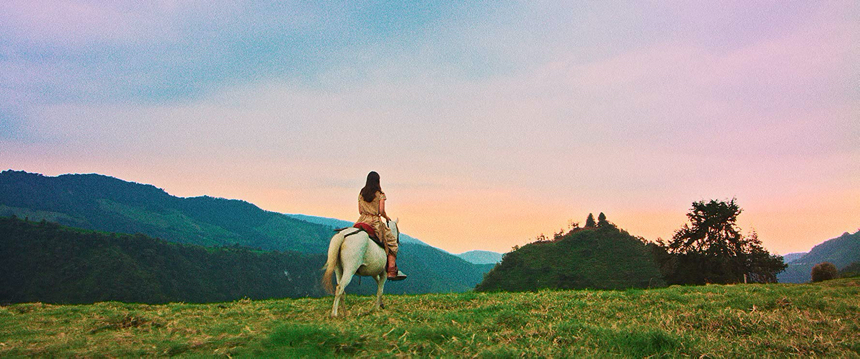Morbido 2019 Review: LUZ THE FLOWER OF EVIL Is A Gorgeous Act of Provocation

The sudden loss of a mother can extract a terrible psychological toll on any family - in any culture or any era. Consider Luz*: The Flower Of Evil, one of the most extreme cases in this regard. A widowed father, only referred to as My Lord (or El Señor in Spanish), remain in the isolated family home with his three adult daughters, Uma, Lailia, and Zion. He acts the spritual centre of both his own family, and that of the small community that lives in the remote upper altitudes of the Colombian Andes.
But El Señor's moral compass is broken by any rational measure. This is acutely underscored by the actual north-pointing device he often uses in the film, which only leads to skeletons in the forest. He imposes some frighteningly strange notions of God onto his daughters, who are on the cusp of rebellion to his apocalyptic preaching of the almighty. Only the fear of his physical and emotional presence keeps the entire family from blowing apart from the pressure of hypocracy and custody. There is an uneasy balance at prayer, be it holding hands for grace at the dinner table, or a similar circle around the tree planted on the mother's (the eponymous Luz) grave.
A tree which refuses to bloom.
In the mean time (pun intended), the daughters spend a lot of time hanging out laundry in the wind. Literally, and figuratively.
Juan Diego Escobar Alzate's hyphenate feature debut (writer, director, location scout) is both an Edenic Technicolor and a bucolic Hell. The film (deservingly) gives 'above the title' credit to its colour timing technician, Felipe Martinez, who, along with the director of photography, offers endless purple skies, looming grey waterfalls, and warm thatch-lined cottage compositions to compliment the barely restrained madness of the narrative.
Attention to period detail is combined with acutely provocative family dynamics, and extreme religion, certainly recalls Rober Eggers' supernatural domestic horror, The Witch. But Luz: The Flower of Evil, is actually set somewhere in the 20th century. The only talisman to indicate the actual time period is a Sony walkman, on which Uma listens to Mozart's Clarinet Quintet in defiance of her father's insistence that music of such exquisite beauty must the work of the devil. It becomes a bargaining chip and a gateway as the film progresses, but is also a signpost of the universality that Christianity has done as much evil in the world as it has done good. For most of us, it is all in our personal perspective on what we wish to emphasize.
Meanwhile, El Señor has been capturing innocent, attractive, boys, which he insists are the second coming of Jesus Christ. He keeps the chained up in the chicken coop with an oxen yolk (symbolism abounds) until their purpose is fulfilled. He is on his fifth Jesus, when the film starts. This is not a good look for a preacher, and the few people that wander onto his property for sermons or spiritual guidance have got to be suspicious at this point.
Like many backwaters, the only book available is The Bible, and El Señor's faith in scripture is absolute. That is, until blame, guilt and other toxic family emotions (emissions? omissions? admissions?) seep into the foundation like a poison. The daughters begin to pry the cracks open, subtly at first, but eventually more brazen. As things get further strained and messy, the images remain resolute and resplendent with gorgeous film grain. You can hug every frame of this film, even as you constantly will recoil in horror.
Not just landscapes and metaphor, Juan Diego Escobar Alzate has a knack for capturing faces here. The wildly bearded and perpetually dirty visage of El Señor; the beatific blonde, blue-eyed semblance of Jesus #5; the natural beauty of the three daughters who look like real women, not stylized film actresses dressing down. The eldest, Uma, is actually played by Tellanovella star Yuri Vargas; albeit she is unrecognizable from the soapy spanish television programming, or red carpet celebrity make-up.
With its frontier setting, and penchant for white horses, the film threatens to slide into a neo-western territory, but the supernatural presence (or indifferent absence) of the Almighty in Gods Country puts the kibosh on any notions of crossing into that (admittedly versatile) genre. However, this is indeed Capital "C" Cinema, in glorious 2.35:1 wide canvas.
Luz: Flower Of Evil asks those big Bergman-ian questions of our existence: "What if faith is a poison and not a comfort?" "What if not all miracles are good?" "If God can be even partially undestood with time, how much time will it take?" And it does so with rainbows and guns, sunsets and shovels...and laundry put out on the line.
For enthusiasts of the recent resurgance of Folk-Horror, from Eggers' The Witch and The Lighthouse, to Ari Aster's Midsommar, and Lukas Feigelfeld's Hagazussa, Luz* is essential viewing.
*(Not to be confused with Tilman Singer's equally wonderful urbane avant-garde possession mind-fuck. What can we say, Luz is a popular name in Colombia.)







